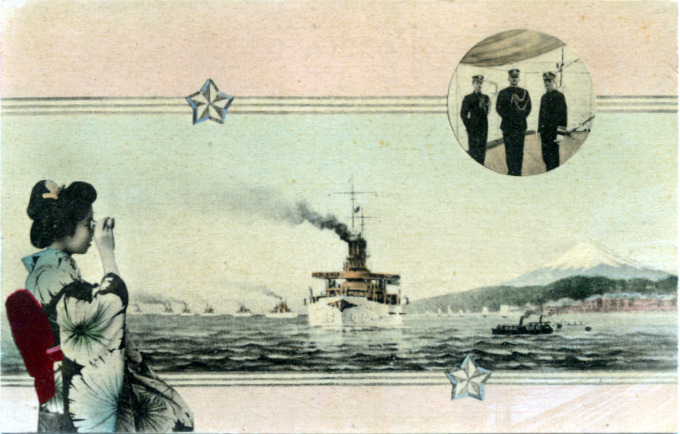
USS Connecticut (BB-18), flagship of the ‘Great White Fleet’, parades the US Navy battleship squadron past Mt. Fuji upon its arrival to Japan, 1908. The hulls of the sixteen battleships in the fleet were painted for peacetime: a stark white, giving the armada its nickname, “Great White Fleet”. The Fleet set off on its circumnavigational voyage in December 1907 – the first ever attempted by such a large fleet of capital ships – steaming out of Hampton Roads (Virginia), cruising around Cape Horn before arriving in Baja California, in preparation for crossing the Pacific Ocean to honor invitations from Japan, Australia, the Philippines, and other countries before returning to Hampton Roads in February 1909.
See also:
“Great White Fleet” being fêted in Yokohama, 1908.
“The Fleets of East and West – of the two greatest naval Powers on the Pacific – met yesterday in peace and amity.
“The delay of a day in the arrival of the White Sixteen, as the visiting Fleet may not inaptly be termed, served only to whet the popular appetite and add to the enthusiasm of the greeting which rich and poor young and old alike are voicing in no halting tones.”
– The Japan Daily Mail, October 24, 1908
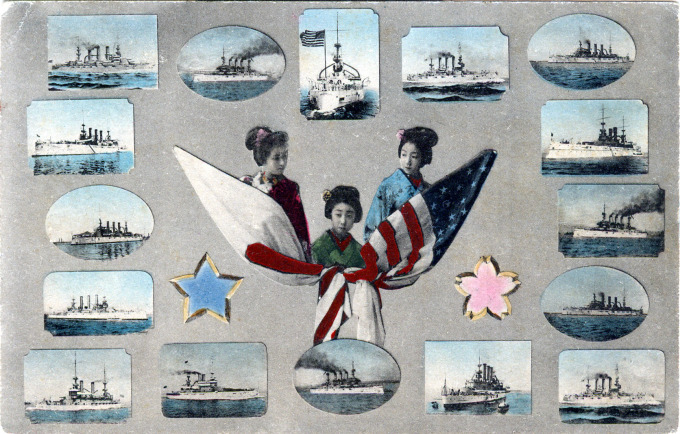
The “Great White Fleet”, 1907-1909. The battleship USS Connecticut (BB-18) was the fleet flagship. It was accompanied by four of the newest US Navy battleships: Minnesota (BB-22), Kansas (BB-21), Vermont (BB-20), Louisiana (BB-19) – plus Georgia (BB-15), New Jersey (BB-16), Virginia (BB-13), Rhode Island (BB-17), Maine (BB-10), Missouri (BB-11), Ohio (BB-12), Alabama (BB-8), and Illinois (BB-7), and the two oldest battleships in the US Navy: Kearsarge (BB-5) and Kentucky (BB-6).
“Roosevelt’s plan for sending America’s battle fleet around the world apparently began to develop in 1905.
“The genesis of this idea may have been his observation of and admiration for the epic transit of Russia’s Baltic Fleet from Saint Petersburg to the Far East to engage the Japanese navy in the Russo-Japanese War, destroy their fleet, and quickly win the war – or so the Czar thought. But it was not to be so. In the ensuing fierce battle [at Tsushima] most of the Russian ships – including all the battleships – were sunk , with only a few ships reaching Russian ports and three cruisers escaping to the Philippines .
“… [Given] Japan’s devastating defeat of the Russian fleet at Tsushima, its growing belligerence in China and Korea, and the rapid growth of its merchant marine, Americans [living] on the West Coast were becoming increasingly uneasy. The initial voyage of the Great White Fleet (from the American East Coast to the West Coast) was clearly an attempt to reassure Americans that their Navy could defend the West Coast.
“Amid growing tensions with Japan in the summer of 1907, it was Admiral George Dewey who first suggested to Roosevelt that the U.S. battle fleet to the Far East as a show of force. During that summer Roosevelt began to consider seriously a ‘world cruise’ for the fleet, but he kept this idea to himself for the time being. [But] in December 1907, the fleet departed Hampton Roads, Virginia, bound for San Francisco.
“The officers and men of the fleet, at this point, were aware that the voyage could possibly continue around the world but the world press was still in speculative mode. As the weeks progressed intentions for the voyage of the Great White Fleet became clear.
“The ships would travel from the West Coast of the United States to New Zealand, Australia, Japan, and the Far East, then to Sri Lanka, through the Suez Canal and the Mediterranean to Spain, and finally across the Atlantic, returning to Hampton Roads in early 1909.
“This would be a 43,000-mile, around-the-globe voyage to twenty ports on six continents. It was a world’s first for a large battle fleet of any nation – an accomplishment that brought envy, concern, pride, or criticism, depending on the source. It was, in any case, an impressive accomplishment for a relatively young nation and a rising naval power.”
– “The Great White Fleet Sails Today: Twenty-First-Century Logistics Lessons from the 1907-1909 Voyage of the Great White Fleet”, by Christopher McMahon, Naval War College Review, Autumn 2018
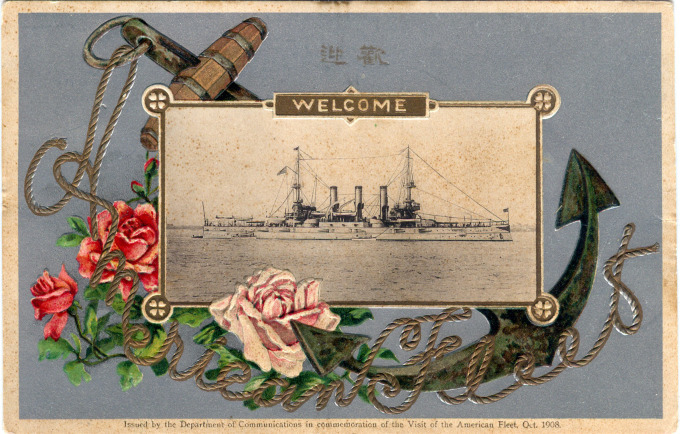
“Issued by the Department of Communications in commemoration of the Visit of the American Fleet, Oct. 1908.” Great White Fleet commemorative postcard, showing the starboard profile of the squadron’s flagship, the USS Connecticut.
“Evans’ flagship was the battleship Connecticut. Connecticut was the latest and best that America had to offer. She was the lead ship of a class of six, the largest single class of battleships ever produced by the United States. Five of the sixteen battleships of the Great White Fleet were from the Connecticut class – Connecticut, Louisiana, Vermont, Kansas and Minnesota. They were among the last of an era as the Royal Navy’s Dreadnought, with her faster speed, thicker armor, and greater firepower, rendered the Connecticut-class and every other pre-dreadnought in the world obsolete.
“[Of the other eleven battleships in the Fleet] Kearsarge is of particular interest, as it is the only American battleship not named for a US state. She was so-named by Act of Congress in commemoration of the Union man-of-war that hunted down the famous Confederate raider Alabama during the Civil War. Kearsarge would go on to enjoy the longest term of uninterrupted service by any battleship in American history.”
– They’ll Have to Follow You!: The Triumph of the Great White Fleet, Mark Albertson, 2007
“[Theodore] Roosevelt recognized the possibility of future problems with Japan in the Pacific and decided to send the U.S. fleet on a world cruise to demonstrate its strength, allow crew members to gain firsthand experience at sea, and encourage Congress to appropriate money for a larger navy. In July 1907, the administration announced that the ‘Great White Fleet’ – sixteen battleships and their escorts – would leave the Atlantic for a practice cruise around the world.
“East Coast Americans complained about being left defenseless, and the chair of the Senate Committee on Naval Affairs piously notified Roosevelt of insufficient funds for the enterprise. The president crisply replied that he had enough finances on hand to move the navy to the Pacific and that if Congress wanted to leave the ships there, that was its decision. Congress allocated the money.
“In December 1907, the Great White Fleet steamed out of Hampton Roads and eventually around Cape Horn, arriving in Baja California and preparing to cross the Pacific and honor invitations from Japan, Australia, and other countries. The Japanese, perhaps wanting a closer view of U.S. naval power, welcomed the sailors with throngs of youths along the roadsides waving small U.S. flags and singing the National Anthem in English.”
– Crucible of Power: A History of American Foreign Relations from 1897, by Howard Jones, 2008
- USS Kearsarge (BB-5), Great White Fleet, the oldest battleship in the fleet..
- ‘Great White Fleet’ at anchor in Tokyo Bay, 1908.
- USS Missouri (BB-11), Great White Fleet.
- USS Minnesota (BB-22), Great White Fleet.
“On October 18 [1908], the Great White Fleet was off Yokohama. It did not take long for the Americans to see that the welcome mat was out. Connecticut’s wireless operator became inundated with a blizzard of welcome signals. Cruisers Mogami, Tatsuta, Soya, and six merchant-men sidled up as escorts. Standing out boldly on the black hulls of the Japanese steamers were large white letters that spelled Welcome. The decks were crammed with soldiers and civilians, among them women and children, waving Japanese and American flags and singing American patriotic songs.”
– They’ll Have to Follow You!: The Triumph of the Great White Fleet, Mark Albertson, 2007


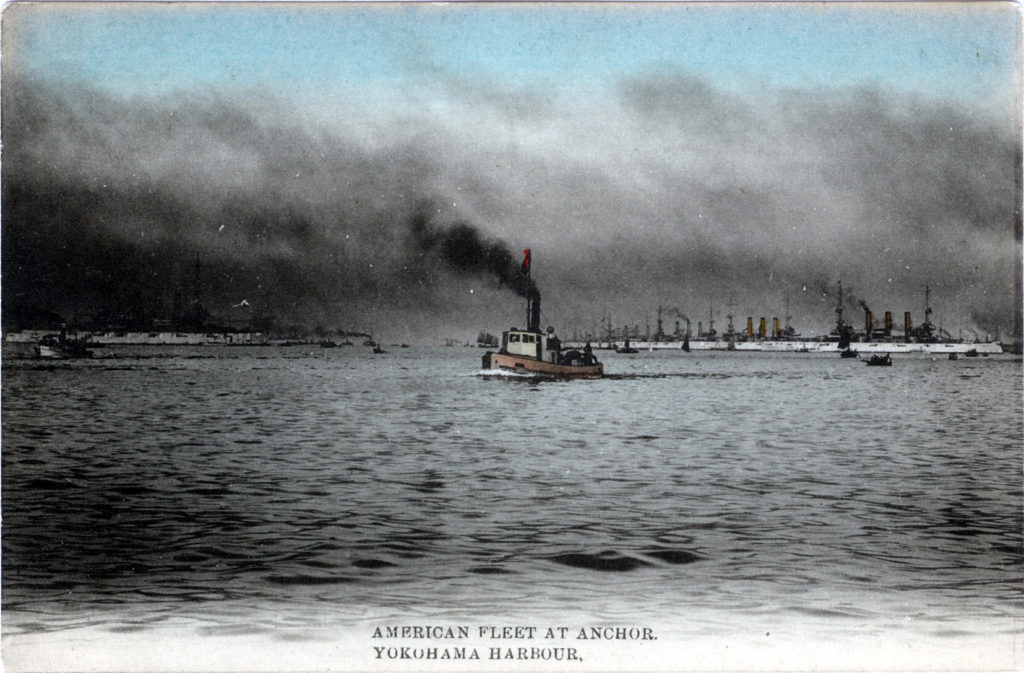
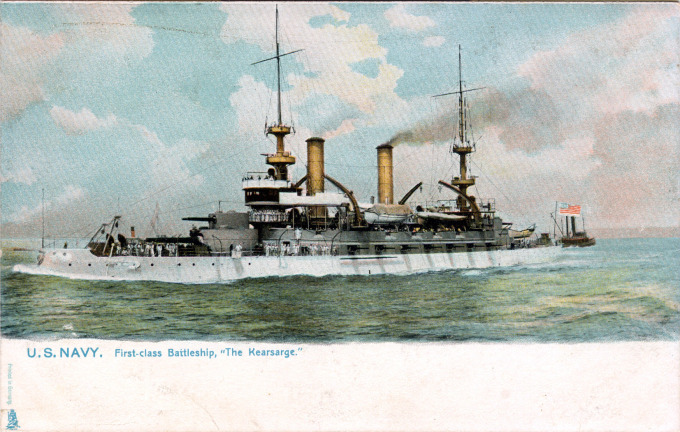
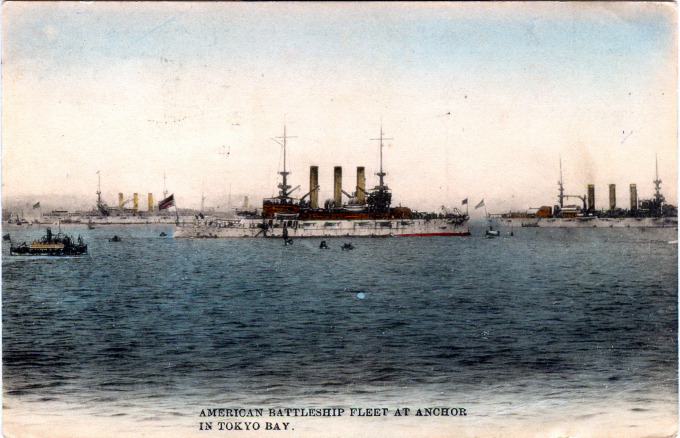
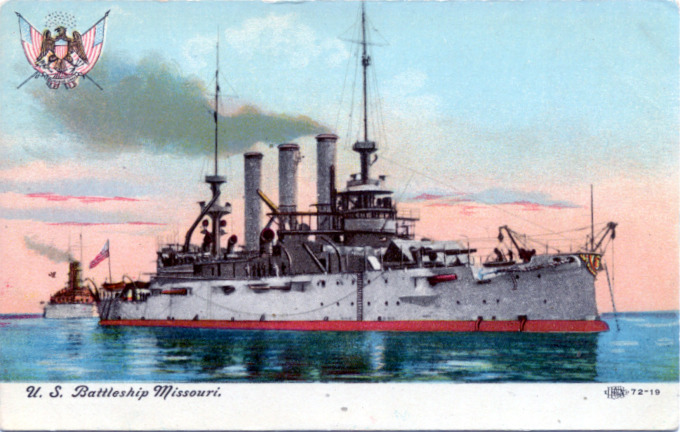
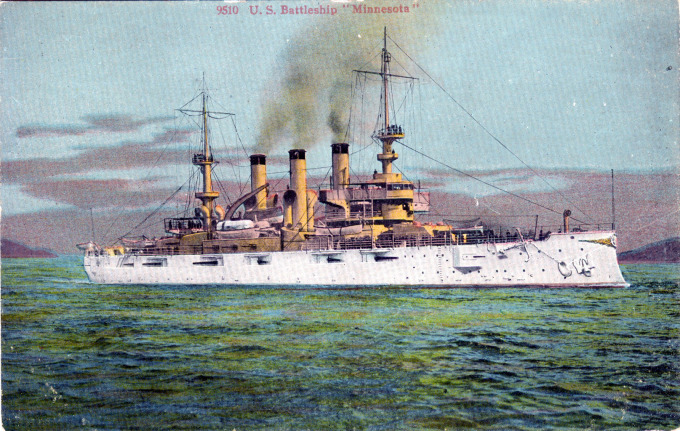
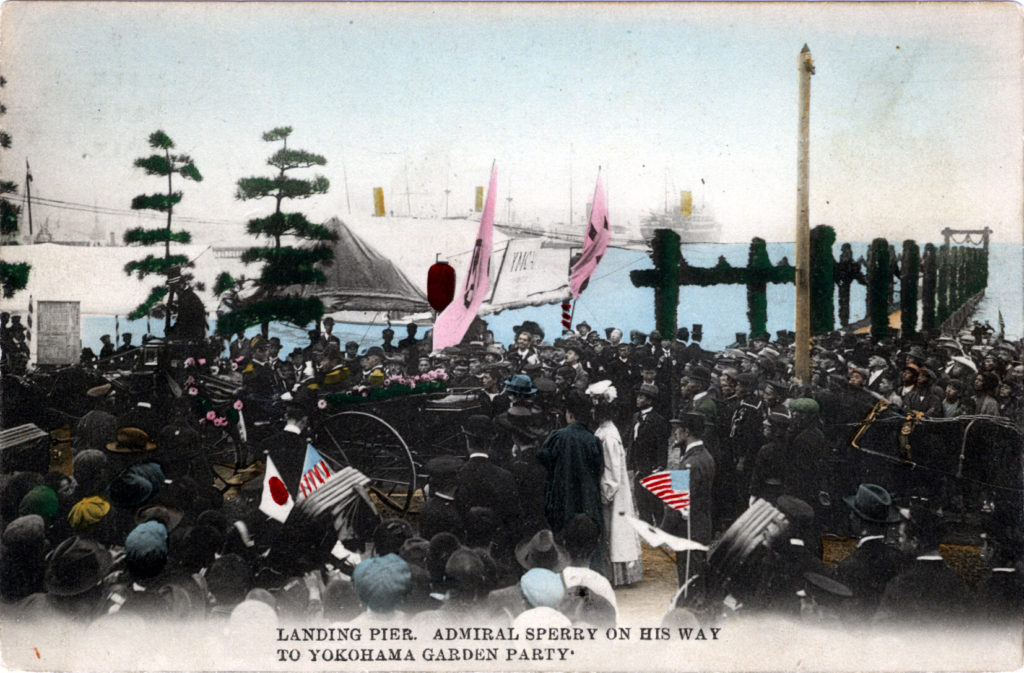
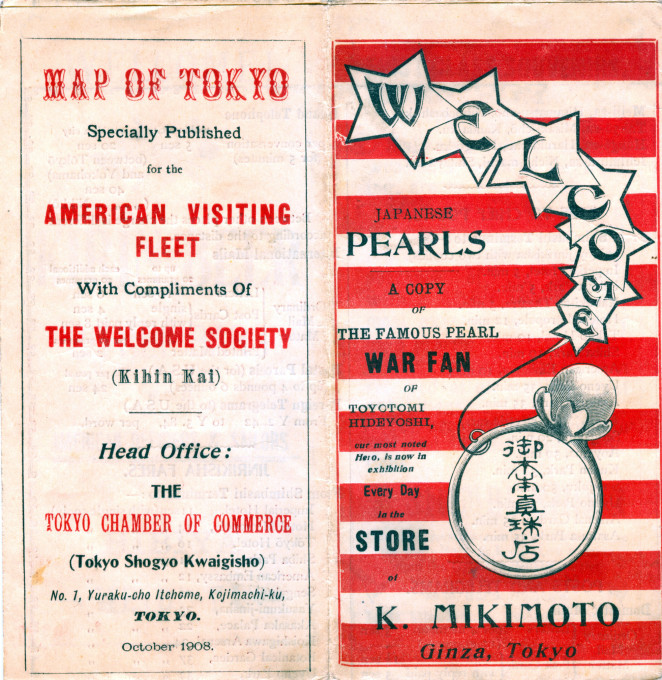
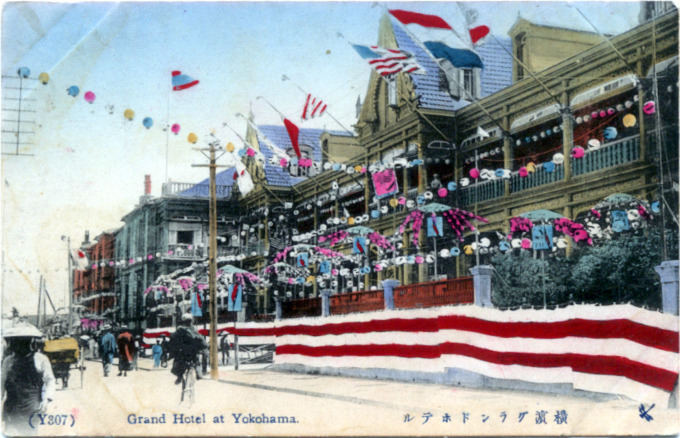
Pingback: Kamakura Station, c. 1910. | Old Tokyo
Pingback: In the Rain of Arashiyama, Kyoto, c. 1910. | Old Tokyo
Pingback: Mitsukoshi Department Store, c. 1903-1923. | Old Tokyo
Pingback: Grand Hotel, Yokohama, c. 1910. | Old Tokyo
Pingback: City Office, Yokohama, c. 1920. | Old TokyoOld Tokyo
Pingback: “Great White Fleet” being fêted in Yokohama, 1908. | Old Tokyo